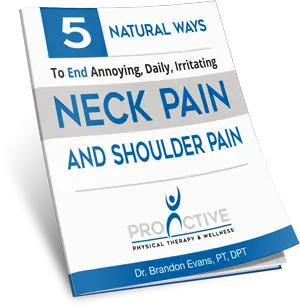
- Do you feel tightness or pain in your shoulder when you make specific movements?
- Is there a sharp, nagging pain when you lift your arm?
- Does it stop you from playing sports or sleeping through the night?
If so, it could be a sign of “shoulder impingement.” This situation occurs when there is excessive rubbing between your rotator cuff tendons and the surrounding bone or connective tissue. If you don’t treat it, it can lead to swelling, soreness, and the inability to perform everyday activities that involve the affected arm. It’s a painful condition that affects many people, particularly athletes or anyone that does lots of overhead shoulder presses in the gym or repeatedly raises their arms at work.
Does that sound like you?
When stiffness occurs in the shoulder joint, as it can with shoulder impingement, it can severely limit your range of motion and make even the simplest tasks painful. Reduced range of motion due to stiffness in the shoulder joint is not only physically challenging but can also affect your emotional well-being.
Whether it’s carrying groceries or playing basketball, weakness in the shoulder can make everything feel like a struggle.
Several factors can contribute to the onset of the symptoms of shoulder impingement, including poor posture, weak shoulder muscles, or bone spurs. But importantly, if you have any of these symptoms, we recommend you consult a physical therapist as soon as possible to prevent further complications and worsening symptoms or possibly even surgery.
The good news is, however, that most people with shoulder impingement fully recover and resume their normal activities with some (not too much) rest, targeted physical therapy, followed by gradually increasing therapeutic movement and strength-building exercises.

The Shoulder: Up Close
The shoulder is one of the human body’s most complex and flexible joints. It’s made up of several different bones and soft tissues, ligaments, and tendons that work together to provide a wide range of motion in each of your arms.
The main bones inside the shoulder joint include the humerus (the upper arm bone), the scapula (shoulder blade), and the clavicle (the collarbone).
Like the hip joint, the shoulder joint is a ball and socket joint, which means that the round end of the humerus (the ball) sits inside a shallow socket inside the scapula bone.
This setup allows your arm to move in all directions: backward, forward, sideways, and round in a circle. The joint also has several ligaments and tendons that stabilize and support the bones during movement. In addition, the rotator cuff specifically surrounds the shoulder joint.
It helps to keep the humerus (the ball) firmly in the socket.
It’s an incredibly complex joint and vital part of the human body that allows for a wide range of motion and physical activity. However, this complexity also makes it more prone to injury and degeneration from overuse, making proper care, attention, and regular physical therapy important for maintaining shoulder health over time and preventing problems like shoulder impingement.

What Is Shoulder Impingement?
There can be a range of potential causes for shoulder pain, but shoulder impingement is among the most common. It is a problem that occurs when the tendons, ligaments, or bursae (fluid-filled sacs) within your shoulder joint become compressed or pinched.
This compression can result in a range of physical symptoms, such as pain or stiffness when raising the arm, weakness in the arm, and difficulty reaching behind your back or overhead.
You may also feel a popping or clicking sensation when you move your arm(s). Also known as “swimmer’s shoulder,” shoulder impingement can significantly limit your mobility and range of motion, preventing you from carrying out your daily activities and enjoying life.
Simple tasks like brushing your hair or reaching for something on a high shelf can become painful and difficult. Activities like swimming or playing sports can also become nearly impossible due to the intensity of the pain. It’s debilitating.
It can be frustrating when such basic movements cause discomfort or pain. This type of pain could be caused by several factors, including muscle strain, a pinched nerve, or even a rotator cuff injury.
But ignoring it can lead to more serious issues down the line, so it’s important to address it as soon as possible. We can help you diagnose the source of the pain and determine the best course of treatment.

What Are The Symptoms Of Shoulder Impingement?
The most symptoms we see when patients present with shoulder impingement at the ProActive Physical Therapy clinic are:
- Pain in the shoulder when lifting your arm overhead
- Dull ache when reaching behind your back or across your body
- Pain while sleeping on the affected side
- Weakness in the shoulder and difficulty completing everyday tasks
- Reduced range of motion due to stiffness in the shoulder joint
What Are The Treatment Options for Shoulder Impingement?
If you suspect you have shoulder impingement, you need to act now to prevent worsening pain and potential should joint degeneration. Physical therapy is by far the most effective treatment to fix shoulder impingement and other shoulder problems. So, the first step to fixing your symptoms is to get in touch with us or another physical therapist near you to get an accurate diagnosis of the underlying cause and a personalized treatment plan.
An accurate diagnosis is key to identifying the relevant treatment options and getting you back to optimal health. For example, without knowing the root cause, you can best mask the pain with anti-inflammatory medication. But this doesn’t resolve the issue; it simply masks the pain.
Learning exercises that target these issues is also beneficial, as they can provide long-term relief. Understanding how and why these things occur can also help you make smarter choices moving forward to maintain healthy shoulders for life.
Plus, It might not be shoulder impingement; it could be something else. That’s why getting a professional evaluation is important to avoid exacerbating the problem with YouTube stretching exercises or other DIY remedies that aren’t suitable for your situation.
Instead, we can guide you through targeted strengthening exercises and stretching techniques that help alleviate your specific symptoms and improve your shoulder function.
If you suspect shoulder impingement, getting an individualized treatment plan to address the issue is important. Don’t try to fix the issue at home because the symptoms and the pain can become chronic or develop into osteoarthritis. So, don’t waste any more time in pain.
Pain from shoulder impingement doesn’t have to limit your daily activities—the treatments we use, such as manual therapy, myofascial release, and targeted exercise programming, can help.
We can also advise you on modifying your lifestyle, which can make all the difference in easing pain and developing better shoulder strength and stability. In most cases, we can fully resolve shoulder impingement so you can get back to living an active, healthy lifestyle without being hampered by pain.
It’s also important to point out that for healing to occur, sleep is paramount. But when you have shoulder pain, getting a good night’s sleep can be difficult. The discomfort can be unbearably disruptive, whether from an old injury, sore muscles, or chronic pain.
Sleep quality is affected, leading to a tired and sluggish feeling the day, further contributing to declining mental health. So, finding a way to alleviate the pain and get better quality sleep is essential.
Whether it’s with body pillows to ease pressure points or utilizing ice or heat to reduce inflammation, a comfortable sleeping position can help promote good sleep hygiene and a restful night. We can help you with this too.
Don’t let shoulder impingement hold you back any longer – take the first step to addressing the issue and regaining optimal shoulder health.

Are You Sick and Tired of Shoulder Pain?
We hope this blog has given you a better understanding of shoulder impingement, its causes, and potential treatments. It can be a frustrating and uncomfortable condition.
Still, various treatment options are available to fix it, including physical therapy and surgery in more severe cases. But if you recognize the symptoms early and get prompt treatment, we can often fully alleviate the pain, so you never require surgery and can return to normal sports and other activities.
Please don’t make the mistake of thinking shoulder pain will go away on its own. It probably won’t, and in most cases, it’s a warning sign from your body that something is wrong, so if you ignore it, things can and do get worse.
Give your body the respect it deserves – let us find and fix the root cause and eliminate your pain. Contact us now.




